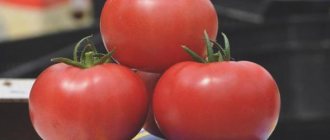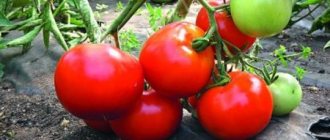Description and varietal characteristics
The choice of variety is influenced by the place of cultivation (indoor, open ground), purpose (use in summer, preparation, storage), and climate of the area. Before purchasing seed material, you need to read the description in order to choose a variety based on your taste preferences and growing conditions.
Description of the Family tomato:
- mid-season - ripening from the moment of emergence takes 110-115 days;
- belongs to the determinant group - compact bushes, height, depending on conditions, reaches 100-110 cm;
- inflorescences are racemose, consist of a large number of flowers, empty flowers are not formed;
- number of ovaries on the hand – 5-6 pieces;
- the fruit is large (weight up to 200 g), round in shape, multi-chambered, rich red in color when fully ripe, dense skin
Related article:
Prohibition" for tomatoes (Kazarin method)
- a peculiarity of the variety is that the stalk, when the ripening process is in progress, has a green spot that disappears when fully ripe;
- the pulp with a rich tomato aroma is dense, sugary in consistency, the taste is dominated by sweetness, and contains little liquid;
- yield - 4-7 kg per bush, in a greenhouse - about 19 kg per square meter;
- ripens well without loss of taste and presentation;
- long-term storage, tolerates transportation well.
The variety is suitable for fresh use, for pickling, making sauces, and lecho. Canning in jars is inconvenient due to its large size. It is not suitable for collecting juice due to the small amount of liquid in the pulp.
The family tomato is suitable for cultivation in protected and open ground. The hybrid tolerates temperature fluctuations and bad weather well, and practically does not get sick.
Related article:
If you are planting tomatoes, don’t forget to throw this into the hole...
In greenhouse conditions, when transplanting seedlings in April, the first fruits can begin to be harvested in late June-early July. In the open ground of mid-latitudes, the timing shifts by 14-20 days. Where the climate is warm, seedlings can be planted in March or early April, so the first harvest will be ready by mid-June.
Pest and disease control
Possessing almost perfect immunity, the Family tomato does not need to be treated with special agents against fungal and infectious diseases. For preventive purposes, it is only recommended to ventilate the greenhouse to remove excess moisture. It is best to ventilate the greenhouse during the daytime to eliminate the possibility of overcooling the plantings.
To control pests, use special insecticides or folk remedies - copper sulfate or soapy water. When grown in open ground, Colorado potato beetles are collected by hand, trying to completely remove their colonies from the green part of the plant.
How to grow seedlings
In order to get the harvest before the onset of autumn cold, Family F₁ is grown by seedlings. The timing of planting directly depends on the time of planting of seedlings. The approximate age of seedlings for transplanting into place is 50-60 days, so you need to subtract this time from the approximate date of planting in the ground and add 4-6 days for the emergence of seedlings.
For example, in the Moscow region, tomatoes are planted in an open ridge in the first ten days of June, in a greenhouse ridge in early May, then, accordingly, the seeds are planted in mid-late March and in late February-early March. At the same time, one should not forget about the growing season of the variety.
Related article:
The best varieties of yellow tomatoes
Preparing soil and seeds
For sowing, use a purchased soil mixture for tomato seedlings or prepare it yourself from a mixture of equal parts of compost, humus, and river sand. For each bucket of the mixture add 0.5 liters of ash. The main components are mixed with ash in the fall and left outside to freeze to destroy pests and their larvae. 2-3 weeks before sowing, the soil mixture is thawed, disinfected with a pink solution of manganese, and a few days later ammonium nitrate and superphosphate are added (2 tbsp each).
The seeds of the hybrids are already ready for use, but to be safe, you can treat them with potassium permanganate - dip them in a weak solution for half an hour. Then rinse with water and dry on a napkin.
Carrying out sowing
Fill boxes and 500 ml cups with soil prepared in advance, lightly compact, water, and leave for 14 days. Then shallow (1 cm) furrows are made in the boxes, holes are made in cups, the seeds are laid out, maintaining an interval of 2-3 cm between them, they are filled in, and moistened with a spray bottle. Plant 2-3 seeds in a glass.
Related article:
How to protect tomato leaves from wilting
The containers are covered with film, glass, and placed in a warm (22-24 ° C) bright place, but not in direct sun. The shelter is opened slightly every day for ventilation, and removed only when half the seeds have sprouted. Shoots should appear in 4-6 days.
Care
After all the seeds have sprouted, the containers are transferred to a cool (17-19 °C) room. A decrease in temperature activates the formation of first-order flower clusters. Care consists of watering with settled water at room temperature and applying fertilizing. The first time is fed after the emergence of seedlings, the second - before picking. A good source of microelements is a weekly infusion of ash (1 tablespoon + 1 liter of water), diluted with water in a 1:1 ratio.
Picking is carried out after the formation of two true leaves. If the roots are too long, pinch off the ends. Seedlings in cups are not transplanted - strong shoots are left and weak ones are removed. The seedlings are ready for planting on the ridge when five true leaves are formed and the stem height reaches 20-25 cm.
Related article:
Growing different varieties of tomatoes
Tips for planting and care
Basic principles to follow when growing Family tomatoes:
- Observe planting dates when sowing seeds for seedlings.
- When choosing a place to plant, observe crop rotation.
- Plant seedlings in the ground (greenhouse) taking into account weather conditions.
- During the entire growing season, fertilize with organic and mineral fertilizers.
Sowing seeds
Prepare the soil for sowing and water it 2 weeks before sowing. In addition to garden soil, take:
- peat;
- humus;
- rotted sawdust;
- river sand;
- ash;
- fertilizers
See also
Productivity with characteristics and description of the Kostroma tomato varietyRead
Mix all the ingredients, pour the prepared soil into the seedling boxes and water well. By the day of planting, the soil will be completely ready for sowing. Seeds should be discarded before sowing.
First, upon visual inspection, remove seeds with defects and damaged ones, then empty (not germinating) seeds by soaking them for 10-15 minutes in water. Discard those that float on the surface.
Place the seeds in seed boxes at intervals of 3 by 4 cm, cover with a 1 cm layer of soil (humus). Cover the boxes with film to maintain soil and air moisture and place them in a room where the air temperature does not fall below 23 °C.
When 50% of the seeds hatch, the film must be removed. When all the seeds have hatched, the room temperature can be reduced to 18-20 °C. This technique allows you to speed up the laying of the first flower clusters. The fruits will be larger in the future.
Picking
Picking - transplanting tomato seedlings from a common box into separate cups with a volume of 0.7 liters or more. Before picking, no later than 3 days in advance, water the seedlings with fertilizer. It is recommended to use potassium nitrate with sodium humate. You can water the fertilizer solution again after a week.
Transplanting seedlings
Seedlings ready for transplanting can be seen by their external signs. The bush has at least 5 leaves, its height is about 25 cm, the trunk is about 7 mm in diameter. It takes 45 to 55 days to form viable seedlings.
Family tomatoes can be planted in polycarbonate greenhouses after April 20th. Pre-water the soil in the holes with warm water to make the roots more comfortable when transplanting.
Transplant into open ground when consistently high night temperatures are established. Frosts on the soil have a detrimental effect on young seedlings. The first week you can install an arc with covering material over the ridge.
Transplanting seedlings into a greenhouse, open ground
Family tomato seedlings are transplanted to a permanent location based on weather conditions. If the soil has warmed up to 10 °C, the period of night frosts has ended, and positive daytime temperatures have established, then the seedlings can be planted. In closed ground, after spilling the ground with hot water, they are planted 3-4 weeks earlier. If the soil is cold, the root system will develop more slowly.
Hardening will help you adapt faster to a new place - take the plants out onto the balcony and tear off the window for a short time. Gradually the procedure time is increased. It begins 10-12 days before transplantation.
The site is prepared in the fall so that the soil becomes structured and settles. When digging, add humus, compost (8-10 kg/1 m²), superphosphate (40 g/1 m²). In the spring, all that remains is to loosen it and disinfect it with Bordeaux mixture.
Related article:
Why do tomatoes drop flowers? 5 possible reasons
In order for the ridge in a greenhouse or outdoors to warm up faster, it is covered with a dark film.
Landing rules:
- dig holes, the depth should correspond to the size of the root system, water;
- maintain a distance of 60-70 cm between the holes, which will allow air to circulate freely between the bushes;
- when the water is absorbed, add a handful of humus, ½ handful of ash, 1 tbsp. l. superphosphate;
- plant a seedling in a clod of earth (to prevent the earth from crumbling, it needs to be watered the day before), fill in the voids, after installing a peg for support, water (4-5 liters per hole);
- tie the stem;
- To protect from the bright sun, build a shelter from spunbond.
Main characteristics
The variety is grown by seedlings. According to reviews of the Family F1 tomato, its fruiting period is somewhat extended. But all season long there will be aromatic and very tasty tomatoes on the table. The harvest can be harvested approximately 115 days after the first shoots appear. The average yield of tomatoes of the Family variety per bush is 4 kg. In some farms the volume reaches 7 kg. You can get a high yield if you follow the rules for growing this tomato. When planting, you must adhere to the following scheme: no more than 3 plants per 1 m2 of soil. You also need to fertilize frequently. Experienced gardeners can get quite impressive results by collecting from a plot of 1 square meter. m 15-20 kg of fruit.
Attention! The Family variety can be grown both in a greenhouse and in open ground. In both cases, tomatoes have strong immunity to various pathogenic pathogens. There is no need to be afraid of the development of root-knot nematode, cladosporiosis, fusarium or tobacco mosaic virus
There is no need to be afraid of the development of root-knot nematode, cladosporiosis, fusarium or tobacco mosaic virus.
Care after transplant
After transplantation, the seedlings are left untouched for 10-12 days, giving them the opportunity to take root and adapt to new conditions. During this period, it is necessary to control the light intensity so that the sun does not burn the leaves.
Feeding
The first fertilizing with a manure solution is carried out as soon as rooting takes place and the first shoots appear. To prepare it, mix manure with water (1 bucket each), leave for a week, and dilute 1:10 before use. Consumption – 1 liter per hole. At the beginning of flowering, humates, simple and double superphosphate, and complex fertilizers (Universal, Kemira Lux, Senior Tomato) are used. When the ovaries appear, feed with magnesium sulfate.
Related article:
What and when to spray tomatoes to save and increase yield
Good to know: Recipes for the best fertilizers for seedlings
Watering
It is recommended to water in the morning or evening, but evening watering is preferable - moisture remains in the ground longer. In the greenhouse, before flowering begins, water every 3-4 days, consumption - 2-3 liters per hole, when flowers appear - once every 7 days, consumption - 5 liters per plant, during the period of fruit formation - moderate watering every 4-5 days . As soon as the tomatoes begin to turn red, reduce the amount of watering.
On an open ridge, watering is carried out depending on the weather. If it is warm and there is no rain, then every two days up to 2 liters are poured under the young plant; in cool weather, water less frequently. As the plant grows, the consumption is increased to 3-5 liters, the frequency of watering is no more than twice a week. During the flowering period, the norm per hole is 5 liters, during the fruiting period - 1.5-2 liters.
Related article:
3 basic rules for growing tomatoes for a good harvest at your summer cottage
If mulch is used, the mode and volume of watering should be reviewed, since moisture evaporates more slowly.
Stepping, bush formation
The Family tomato, as a representative of determinate varieties, has three stems formed in protected soil. To do this, do not remove the first two stepsons, shortening them after the formation of the first cluster of flowers. 1-2 stems are formed on an open ridge. If one stem is desired, then leave the top, removing all the stepsons; if there are two, then the first stepson is not touched, all subsequent ones are removed.
Pruning (removal of side shoots) is carried out every 10 days. The shoot is pinched or cut off, leaving a small stump - it is needed so that a new shoot does not begin to grow in this place again. At the same time, remove the lower leaves - 1-3 at a time.
Related article:
5 ways to use tomato tops for all occasions
Hilling, loosening, mulching
Until the tomatoes have grown much, the soil is loosened to a depth of 3 cm every two weeks. At the same time, weeds are removed. When they grow, the row spacing is loosened less frequently. To keep the soil loose and retain moisture longer, it is mulched with dry grass, chopped branches, straw, rotted compost, old sawdust (fresh sawdust increases acidity). A 6-8 cm layer of mulch allows air to pass through, retains light, interferes with grass growth, and reduces evaporation.
The first hilling is carried out 2-3 weeks after planting the seedlings. Raking soil towards the trunk creates conditions for the formation of additional roots. The next hilling is in two weeks. The soil near the stems gradually erodes, so they hill up several times a season.
Treatment against pests and diseases
Preventive spraying against possible infections is carried out every two weeks throughout the season. A good effect is achieved by using the plant-safe product Fitosporin. It is diluted in a ratio of 1:10 and sprayed on the bushes in the morning.
Related article:
To prevent tomatoes from becoming fattened with greens: 5 tricks
Prevention of damage by insect pests will be spraying with folk remedies: infusion of garlic, onion peels, tobacco, ash, solution of soda and iodine.
Harvesting and application
The yield of the variety is friendly, so tomatoes are harvested immediately after ripening. It is better to pick along with the stalk so that the vegetable can be stored longer. If you pick a green tomato, it will ripen quietly on the windowsill or balcony. In general, the variety stores well, especially if you place the crop in a dark, dry and ventilated place.
The variety is used in cooking. Used fresh and after heat treatment. The family variety excels as appetizers, salads, side dishes, and soups. It also makes excellent adjika and tomato ketchup.
Reviews
Polina Matveevna, Saratov:
“Last year I planted Family hybrid tomatoes for the first time. The tomatoes grew medium in size, and there were also a lot of large ones. I tried to marinate them in cut form, because they don’t have much juice. The result was pleasing - the halves did not fall apart, the pulp was completely preserved, and was well soaked in the marinade. I added more sugar to the marinade and put ½ tsp in the jar before rolling. mustard seeds. I also used large tomatoes to make lecho. The cut pieces were well preserved during cooking and did not turn into a solid mass.”
Boris Petrovich, Yekaterinburg:
“In the spring, our weather is unstable, so I grow tomatoes in a greenhouse, but if there are seedlings left, I plant them outside. I cover the first half of June at night - I have high arches. I also plant the Family variety in the greenhouse and in the garden bed. If we compare the results, the bush grows less outside, becomes more compact, and bushes more strongly in the greenhouse. I rooted and removed leaves in the greenhouse more often than outside. The sizes of tomatoes vary, but there are more large ones than medium ones. I fed them only with my own fertilizers: I infused grass with yeast and manure.”
Description of tomato Family
The Family tomato variety is a determinate hybrid. The bushes are no more than 1.1 m high and have powerful spreading stems. Thanks to this, they can withstand the weight of numerous fruits. The leaves are rich green, slightly wrinkled. Their shape is a bit like a tomato. Many flowers are combined in one inflorescence. The Family variety compares favorably with others in that it does not have barren flowers. Already 3.5 months after germination, tomatoes fully ripen.
Description of fruits
The tomato is round in shape. It has several chambers filled with seeds. As it ripens, large green spots appear near the stalk. This is normal; when the fruit is completely ripe, the stain will disappear. The delicate skin will acquire an even scarlet tone. Tomatoes are not prone to cracking. Their flesh is quite dense and has a velvety texture. Tomatoes of the Family variety are large; one tomato weighs from 180 to 200 g. If you fertilize the bushes correctly, you can get fruits weighing about 350 g, but this requires experience. Tomatoes have a rich aroma and a pleasant sweet and sour taste. They are suitable for summer salads, making juices, homemade tomato paste and ketchup.
Sowing seeds
Before planting in the chosen location, seedlings should be sown 45-55 days in advance. If the need arises, the soil should be moistened, then furrows should be made. Grooves are made every 4 centimeters. You need to spread the seeds 10 mm apart at intervals of about 3 centimeters.
If you do not plan to pick, you can sow the seeds directly into cups or cassettes. In this case, transplanting seedlings into larger containers will not injure the roots. Some tomato lovers use newspaper cups and then plant them directly into them. Boxes, cups and all other containers should be placed in the window that receives the most light. After five to six days, at a temperature of approximately 20-23 degrees, the first shoots will appear.
Read also: How to prepare a bed for garlic? How to fertilize a bed for planting garlic
Irina, 24, Moscow One of my favorite tomatoes! This is my second season of planting at the dacha and I’ve been pleased both times. I fed the seedlings before planting, monitored the soil moisture, and periodically loosened the soil. I didn't do anything special anymore. I recommend to everyone.
Gennady Viktorovich, 56 years old, Ufa Although they say that this variety grows in any conditions, I would argue with that. At a temperature of 24-25 degrees, my leaves began to lose their elasticity. The tomato still doesn’t like high temperatures, I lowered the temperature to 16-57 degrees and only then everything became good.
Olesya, 29 years old, St. Petersburg I was rather cool about hybrid varieties, but the “Family” tomato made me change my opinion about them. Incredibly tasty tomatoes, I ate almost five of them at one time! For me, the downside is that the seedlings need to be fed with fertilizers. At first I didn’t want to do this, but I read that it was necessary, this is a feature of all hybrid varieties. If you want a stable harvest, choose this variety, you won’t regret it.










